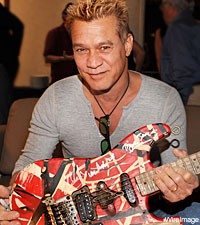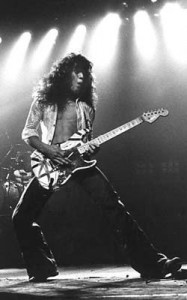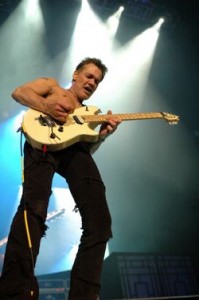 Edward Van Halen turns 56 today.
Edward Van Halen turns 56 today.
Ed has given the world a gift, three decades of musical genius. His approach to the guitar has given birth to an entire generation of guitar players who look at the guitar as an instrument with unlimited possibilities. He introduced a myriad of new styles and sounds that will be scrutinized for decades.
It all started in Amsterdam, Holland, on 1/26/55. Edward Lodewijk van Halen (“Lodewijk” is pronounced “Load-ah-vike”) was born. From the age of six until the age of twelve he was trained in classical piano by his father and a Russian teacher, Stass Kalvitis.
By the age of twelve Ed had discovered rock and roll. Inspired by the Dave Clark Five’s “Glad All Over” and “Bits and Pieces,” he decided to become a drummer. After switching instruments with Alex, the first song Eddie played on his brother’s guitar was the Ventures’ “Walk, Don’t Run” (BLP 2031, 1964). He also took up the violin and cello at this time.
A friend of Jan Van Halen built an amp for Ed, and for the first time he was plugged in. One of the first songs played through this amp was the Arrow’s “Blues Theme.” The amp was short-lived, though, and in 1969 Ed bought his Marshall amp, which has since become the most famous amp in rock history.
Eddie’s favorite band was Cream. A Clapton fanatic to this day, he took it upon himself to memorized and perform Cream songs note-for-note. He became locally famous for it. Clapton wasn’t his only influence, though. Jimmy Page seemed to embody more of what Ed was really about, feeling over accuracy. It was Page who inspired Eddie to develop his tapping technique. Jimi Hendrix seemed to perplex Edward, however. Although he liked Hendrix’s whammy bar techniques enough to build on them within his own style, Ed was never comfortable playing Hendrix’s songs.
 In these early years Ed was both a guitar player and a lead singer for his band Mammoth, nicknamed Junior Cream. Ed hated singing lead, though, and the lineup of Mammoth changed to include David Lee Roth.
In these early years Ed was both a guitar player and a lead singer for his band Mammoth, nicknamed Junior Cream. Ed hated singing lead, though, and the lineup of Mammoth changed to include David Lee Roth.
“I never technically learned how to sing,” Ed remembered on the Drew and Mike show on Detroit’s WRIF in 1996. “So, I would kind of do a Kurt Cobain, after five songs and three beers my voice would be gone. You know, I would just scream it out and kind of waste my voice.”
The band transformed from a high concept technical band to a hard pounding party band. By 1974 Mammoth was an established band on the local scene and Eddie had developed his tapping technique into a recognizable, unique style. This is not to say that Eddie was the only one tapping at this time. Several musicians had been doing similar techniques for decades. Tapping was not new, but Eddie didn’t know that. He developed his own style independent of outside tapping influences. It was this style that brought the technique to the forefront of rock guitar in the late 1970s.
Rather than helping the band, Ed was actually keeping the band from getting the best gigs. When they became known as Van Halen, they tried to get gigs at the popular Los Angeles clubs, but Eddie was too loud. He had to be. In order for his Marshall to sound its best, it had to be turned up to 10 at all times. To rectify this Ed would turn his amp around or put padding in front to muffle the sound. Later, Ed used a Variac to adjust the voltage instead of the volume, so the amp would always sound its best. Eventually it all paid off and the band was accepted into Gazzari’s. Other prestigious gigs followed as the band spent about three years working the club circuit.
During the club years the band recognized the talent they had in Eddie. Alex, the closest thing the band had to a manager the early club days, suggested that Eddie should probably conceal some of his more innovative techniques from the audiences, which at times included guitarists from all over the L.A. scene including Randy Rhodes. 
“Yeah, that is kinda like Alex telling me, ‘Hey, wait until we have it on a record; their gonna rip it.'” Ed recalled. “Ya know, when I started doing the two- hand technique, as soon as the record came out, everyone did it.” (WRIF, 1996)
It wasn’t long before there was a buzz around town about this band and their amazing guitar player. It wasn’t until after the band had been discovered that “Eruption” was unveiled to producer Ted Templeman. Ted saw the potential of the ground-breaking instrumental and soon guitarists from around the world, in their studios and in their garages, would be spending countless hours trying to copy it. Ed was just getting started. His talent has never lied in any one technique, but in his ability to translate the sounds in his heads to the guitar. If that means coming up with a new innovative technique to achieve that sound, so be it.
While on tour in support of Van Halen, Ed added another innovation to his repertoire. It was a combination of tapping and harmonics that came to be known as “False Harmonics.” Again, this was a technique Eddie developed independently, though it had been used by Jazz guitarists since the 1950s. The technique can be heard most prominently on the track “Dance the Night Away.”
At the end of 1979 Ed was voted Guitar Player’s Best Rock Guitarist. He had enough money to retire his father and buy him a boat. Eddie resurrected “And the Cradle Will Rock,” a song he and Alex struggled with in 1974, with keyboards for the band’s 1980 album Women and Children First. Though the keyboards were subtle, it marked a new beginning for Eddie. He refused to be confined to the guitar to express his musical ideas.
The band embarked on the World Invasion tour. It was on this tour that Eddie met Valerie Bertinelli backstage at the Hirsh Memorial Arena in Shreveport, Louisiana, on 8/29/80. Seven months later they were married. Rumors starting spreading that Roth was unhappy with Ed’s new lifestyle. Ed wasn’t exactly the member of Van Halen expected to marry a famous actress or hang out with Hollywood’s A-list.
Eddie’s personal life was going well, but his life in Van Halen was getting worse. He was frustrated that he hadn’t been expressing himself fully on the last few Van Halen albums. The party was over. After recording three albums and going on three tours in three years the band was set to do the same thing for the fourth album Fair Warning. Ed was admittedly depressed and made it clear to some that he no longer wanted to be in the band. During the recording of Fair Warning, he would often sneak into the recording studio late at night and rerecord his guitar parts the way he wanted them. He feared that the rest of the band wouldn’t approve of some the musical risks he was taking in his solos. He even included a haunted growling keyboard instrumental called “Sunday Afternoon in the Park,” that truly made this Ed’s album.
What came out of the recordings was a dark, heavy guitar album that many die-hard Van Halen fans consider the best written of the Dave-era albums. However, it was the least popular in terms of sales. Ed was more reluctant to step out and take control for the next album and instead concentrated more on making guitars and refining his own position in the band.
 There were excuses now to set aside Eddie’s style on the next album and go back to the formula that sold albums: covers plus lots of Dave equals record sales. To a certain extent they were correct, but the band suffered musically. They were determined to get back the legions of adoring pop fans and the result was 1982’s Diver Down, Ed’s least favorite album. He rarely liked cover tunes and this album was loaded with them. Ted wanted to use an original composition written by Ed for a cover, “Dancing in the Street,” something Ed would later regret terribly.
There were excuses now to set aside Eddie’s style on the next album and go back to the formula that sold albums: covers plus lots of Dave equals record sales. To a certain extent they were correct, but the band suffered musically. They were determined to get back the legions of adoring pop fans and the result was 1982’s Diver Down, Ed’s least favorite album. He rarely liked cover tunes and this album was loaded with them. Ted wanted to use an original composition written by Ed for a cover, “Dancing in the Street,” something Ed would later regret terribly.
Tensions in the band between Eddie and Dave that began when Fair Warning was released were now coming to a head. The building of the 5150 Studio marked the beginning of the end of the power struggle between Ed and Dave. Constructed in March of 1983, 5150 has been the recording studio every Van Halen album has been recorded in since. It lies just down the road from Ed’s house.
The result of the struggle within the band for freedom of expression was 1984.
The next few years would hold many changes for the band as a whole, but for Ed it meant more freedom to explore different styles of music and to stray a bit from his expected position atop the heap of ’80s speedster guitar heroes. Even with those changes, Eddie only got more and more popular.
From The Van Halen Encyclopedia by C.J. Chilvers